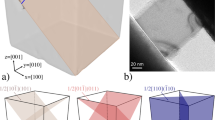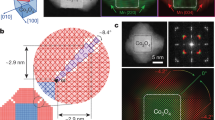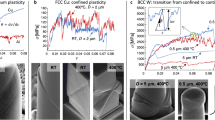Abstract
Extended microscale crystal defects, including dislocations and stacking faults, can radically alter the properties of technologically important materials. Determining the atomic structure and the influence of defects on properties remains a major experimental and computational challenge. Using a newly developed simulation technique, the structure of the 1/2a <100> screw dislocation in nanoporous zeolite A has been modelled. The predicted channel structure has a spiral form that resembles a nanoscale corkscrew. Our findings suggest that the dislocation will enhance the transport of molecules from the surface to the interior of the crystal while retarding transport parallel to the surface. Crucially, the dislocation creates an activated, locally chiral environment that may have enantioselective applications. These predictions highlight the influence that microscale defects have on the properties of structurally complex materials, in addition to their pivotal role in crystal growth.
This is a preview of subscription content, access via your institution
Access options
Subscribe to this journal
Receive 12 print issues and online access
$259.00 per year
only $21.58 per issue
Buy this article
- Purchase on Springer Link
- Instant access to full article PDF
Prices may be subject to local taxes which are calculated during checkout




Similar content being viewed by others
References
Lai, Z.P. et al. Microstructural optimization of a zeolite membrane for organic vapor separation. Science 300, 456–460 (2003).
Terasaki, O., Thomas, J.M. & Ramdas, S. A new type of stacking-fault in zeolites - presence of a coincidence boundary (square-root 13. square-root 13 R32.2-degrees superstructure) perpendicular to the tunnel direction in zeolite-L. J. Chem. Soc. Chem. Commun. 216–217 (1984).
Campbell, B.J. & Cheetham, A.K. Linear framework defects in zeolite mordenite. J. Phys. Chem. 106, 57–62 (2002).
Sinclair, J.E. Improved atomistic model of a bcc dislocation core. J. Appl. Phys. 42, 5321–5329 (1971).
Gehlen, P.C., Hirth, J.P., Hoagland, R.G. & Kanninen, M.F. A new representation of the strain field assoceated with the cube-edge dislocation of a-iron. J. Appl. Phys. 43, 3921–3933 (1972).
Ismail-Beigi, S. & Arias, T.A. Ab initio study of screw dislocations in Mo and Ta: a new picture of plasticity in bcc transition metals. Phys. Rev. Lett. 84, 1499–1502 (2000).
Yang, L.H., Söderlind, P. & Moriarty, J.A. Accurate atomistic simulation of (a/2)<111> screw dislocations and other defects in bcc tantalum. Phil. Mag. A 81, 1355–1385 (2001).
Kaplan, T., Liu, F., Mostoller, M., Chisholm, M.F. & Milman, V. First-principles study of impurity segregation in edge dislocations in Si. Phys. Rev. B 61, 1674–1676 (2000).
Liu, F., Mostoller, M., Chisholm, M.F. & Kaplan, T. Electronic and elastic properties of edge dislocations in Si. Phys. Rev. B 51, 17192–17195 (1995).
Bigger, J.R.K. et al. Atomic and electronic structures of the 90° partial dislocation in silicon. Phys. Rev. Lett. 69, 2224–2227 (1992).
Heggie, M.I., et al. Glide dislocations in dimond: first-principles calculations of similarities with and differences from silicon and the effects of hydrogen. J. Phys. Condens. Matter 14, 12689–12696 (2002).
Martsinovich, N. Heggie, M.I. & Ewels, C.P. First-principles calculations on the structure of hydrogen aggregates in silicon and diamond. J. Phys. Condens. Matter 15, S2815–S2824 (2003).
Rabier, J., Soullard, J. & Puls, M.P. Atomic calculations of point-defect interactions with an edge dislocation in NiO. Phil. Mag. A 61, 99–108 (1990).
Rabier, J. & Puls, M.P. On the core structures of edge dislocations in NaCl and MgO. Consequences for the core configurations of dislocation dipoles. Phil. Mag. A 59, 821–842 (1989).
Puls, M.P., Woo, C.H. & Norgett, M.J. Shell-model calculations of interaction energies between point defects and dislocations in ionic crystals. Phil. Mag. 36, 1457–1472 (1977).
Puls, M.P. & Norgett, M.J. Atomic calculation of the core structure and Peierls energy of an (a/2)[110] edge dislocation in MgO. J. Appl. Phys. 47, 466–477 (1976).
Puls, M.P. Vacancy-dislocation interactions energies in MgO A re-analysis. Phil. Mag. A 47, 497–513 (1983).
Puls, M.P. Vacancy-dislocation interaction energies in MgO. Phil. Mag. A 41, 353–368 (1980).
Hoagland, R.G., Hirth, J.P. & Gehlen, P.C. Atomic simulation of the dislocation core structure and Peirels stress in alkali halide. Phil. Mag. 34, 413–439 (1976).
Watson, G.W., Kelsey, E.T. & Parker, S.C. Atomistic simulation of screw dislocations in rock salt structured materials. Phil. Mag. A 79, 527–536 (1999).
Dumrul, S., Bazzana, S., Warzywoda, J., Biederman, R.R. & Sacco, A. Imaging of crystal growth-induced fine surface features in zeolite A by atomic force microscopy. Micropor. Mesopor. Mater. 54, 79–88 (2002).
Nabarro, F.R.N. Theory of Dislocations (Oxford Univ. Press, Oxford, 1967).
Binder, G., Scandella, L., Schumacher, A., Kruse, N. & Prins, R. Microtopographic and molecular scale observations of zeolite surface structures: Atomic force microscopy on natural heulandite. Zeolites 16, 2–6 (1996).
Agger, J.R., Pervaiz, N., Cheetham, A.K. & Anderson, M.W. Crystallization in zeolite A studied by atomic force microscopy. J. Am. Chem. Soc. 120, 10754–10759 (1998).
Agger, J.R., Hanif, N. & Anderson, M.W. Fundamental zeolite crystal growth rates from simulation of atomic force micrographs. Angew. Chem. Int. Edn 40, 4065–4067 (2001).
Faux, D.A., Smith, W. & Forester, T.R. Molecular dynamics studies of hydrated and dehydrated Na+- zeolite-4A. J. Phys. Chem. B 101, 1762–1768 (1997).
Slater, B., Titiloye, J.O., Higgins, F.M. & Parker, S.C. Atomistic simulation of zeolite surfaces. Curr. Opin. Solid State Mater. Sci. 5, 417–424 (2001).
Smit, B. & Siepmann, J.I. Simulating the adsorption of alkanes in zeolites. Science 264, 1118–1120 (1994).
Auerbach, S.M. Theory and simulation of jump dynamics, diffusion and phase equilibrium in nanopores. Int. Rev. Phys. Chem. 19, 155–198 (2000).
Henson, N.J., Cheetham, A.K. & Gale, J.D. Theoretical Calculations on Silica Frameworks and Their Correlation with Experiment. Chem. Mater. 6, 1647–1650 (1994).
Poirier, J.P. Rheology of ices: a key to the tectonics of the ice moons of Jupiter and Saturn. Nature 299, 683–688 (1982).
Nelson, J. Growth mechanisms to explain the primary and secondary habits of snow crystals. Phil. Mag. A 81, 2337–2373 (2001).
Li, L., Raterron, P., Weider, D. & Chen, J. Olivine flow mechanisms at 8 GPa. Phys. Earth Planet. Inter. 138, 113–129 (2003).
Sanders, M.J., Leslie, M. & Catlow, C.R.A. Interatomic potentials for SiO2 . JCS Chem. Commun. 1271–1273 (1984).
Wolf, D., Keblinski, P., Phillpot, S.R. & Eggebrecht, J. Exact method for the simulation of Coulombic systems by spherically truncated, pairwise r−1 summation. J. Chem. Phys. 110, 8254–8282 (1999).
Gale, J.D. & Rohl, A.L. The general utility lattice program (GULP). Mol. Simulat. 29, 291–341 (2003).
Cheetham, A.K., Eddy, M.M., Jefferson, D.A. & Thomas, J.M. A Study of Si,Al ordering in thallium zeolite-a by powder neutron-diffraction. Nature 299, 24–26 (1982).
Bell, R.G., Jackson, R.A. & Catlow, C.R.A. Lowenstein rule in zeolite-a — a computational study. Zeolites 12, 870–871 (1992).
Hull, D. & Bacon, D.J. Introduction to Dislocations (Pergamon, Oxford, 1984).
Steeds, J.W. Introduction to Anisotropic Elasticity Theory of Dislocations (Clarendon, Oxford, 1973).
Sinclair, J.E., Gehlen, P.C., Hoagland, R.G. & Hirth, J.P. Flexible boundary conditions and nonlinear geometric effects in atomic dislocation modeling. J. Appl. Phys. 49, 3890–3897 (1978).
Hirth, J.P. Anisotropic elastic solutions for line force arrays. Scripta Metall. 6, 535–540 (1972).
Rao, S., Hernandez, D., Simmonds, J.P., Parthasarathy, T.A. & Woodward, C. Green's function boundary conditions in two-dimensional and three-dimensional atomistic simulations of dislocations. Phil. Mag. A 77, 231–256 (1998).
Acknowledgements
We thank Al Sacco Jr and colleagues for the AFM image shown in Fig. 1. B.S. wishes to acknowledge useful discussions with Jonathan Agger. We thank EPSRC for funding for local computer resources (GR/S06233/01), access to the UK capability computing resource (HPCx) via the Materials Chemistry Consortium (GR/S13422/01) and a studentship to A.M.W. J.D.G. gratefully acknowledges the support of the Government of Western Australia through a Premier's Research Fellowship. K.W. thanks the Royal Society for support under their University Research Fellowship scheme.
Author information
Authors and Affiliations
Corresponding authors
Ethics declarations
Competing interests
The authors declare no competing financial interests.
Supplementary information
Supplementary Information, Figures
Fig. S1, Fig. S2 and Table S1 (PDF 126 kb)
Rights and permissions
About this article
Cite this article
Walker, A., Slater, B., Gale, J. et al. Predicting the structure of screw dislocations in nanoporous materials. Nature Mater 3, 715–720 (2004). https://doi.org/10.1038/nmat1213
Received:
Accepted:
Published:
Issue Date:
DOI: https://doi.org/10.1038/nmat1213
This article is cited by
-
Role of dislocation elastic field on impurity segregation in Fe-based alloys
Scientific Reports (2021)
-
Predicting crystal growth via a unified kinetic three-dimensional partition model
Nature (2017)
-
In silico prediction and screening of modular crystal structures via a high-throughput genomic approach
Nature Communications (2015)
-
Simulation of screw dislocations in wadsleyite
Physics and Chemistry of Minerals (2010)
-
Implications for plastic flow in the deep mantle from modelling dislocations in MgSiO3 minerals
Nature (2007)



